Comments / Questions (35)
![]() Kirsten Jensen wrote:
Kirsten Jensen wrote:
Dejligt sjal - for at lukke meget løst af, gjorde jeg det ved at strikke 2 masker og tage 1. Maske over, så strikkede jeg masken under den næste maske og tog 1 over. På den måde får man næsten dobbelt antal masker at lukke af, men sikke en forskel det gjorde.
30.05.2025 - 14:23
![]() Grete Heyn wrote:
Grete Heyn wrote:
Jeg kan ikke se at det står hvor mange masker man legger opp.
17.03.2025 - 16:21DROPS Design answered:
Hei Grete. Legg opp 2 m på rundp 4 med Kid-Silk. Mvh DROPS Design
18.03.2025 - 07:53
![]() Tiziana wrote:
Tiziana wrote:
Buongiorno, scusate ma le informazioni in italiano per la realizzazione di questo modello non sono chiare . È possibile avere uno schema semplice e chiaro per poterlo realizzare? Anche le informazioni che avete riportato per altri modelli di scialli, non sono chiare e sufficienti per capire quali passi di esecuzione vadano compiuti. Grazie mille e buona giornata
15.01.2025 - 09:32DROPS Design answered:
Buonasera Tiziana, ci può indicare quale parte delle spiegazioni le crea problemi? Buon lavoro!
15.01.2025 - 17:30
![]() Nathalie wrote:
Nathalie wrote:
Il s'agit probablement d'un problème de traduction mais je ne comprends pas ce qui est indiqué dans les explications des points fantaisie (voir partie entre ""): Tricoter et augmenter "comme avant au-dessus des 4 premières m", tricoter à l'end jusqu'à ce qu'il reste 4 m, 4 m end.
13.01.2025 - 16:37DROPS Design answered:
Bonjour Nathalie, tricotez simplement les 4 premières mailles comme avant en augmentant comme vous l'avez fait auparavant, tricotez ensuite à l'endroit jusqu'à ce qu'il reste 4 mailles avant la fin du rang et tricotez les 4 dernières mailles à l'endroit. Bon tricot!
13.01.2025 - 16:50
![]() Jan Whiting wrote:
Jan Whiting wrote:
How many balls of 25g do I need for this please. I can't seem to find where it is stated. Thanks
22.07.2024 - 16:42DROPS Design answered:
Hi Jan, for whole shawl you need 75g of DROPS Kid Silk, that means 3 balls. See material list in the header next to main photo. Happy knitting!
22.07.2024 - 18:29
![]() Carmen wrote:
Carmen wrote:
Buonasera, vorrei sapere cortesemente se il ferro 2 del punto con buchini va lavorato così: 1 maglia a dritto, 1 gettato, 1 maglia dritta e un gettato, poi a rovescio fino alle ultime 4 maglie, poi 4 maglie dritte. Oppure si lavora 1 maglia a rovescio, 1 gettato, 1 rovescio, 1 gettato poi a rovescio fino alle ultime 4 maglie, poi 4 maglie dritte? Grazie
09.03.2024 - 21:16DROPS Design answered:
Buonasera Carmen, deve lavorare come indicato, quindi a diritto. Buon lavoro!
17.03.2024 - 21:19
![]() Ieva wrote:
Ieva wrote:
Hallo, verstehe ich es richtig, dass bei Krausrippe in allen 4 Reihen je 6 Maschen zugenommen werden (je 3 an jeder Seite) = in 32 Reihen werden 48 Maschen zugenommen? Bei Lochmusster jedoch in allen 4 Reihen am Anfang werden insgesammt 8 Maschen zugenommen (4 M an jeder Seite) (1M re, 1 Umschlag, 1 M re, 1 Umschlag)? Ist das korrekt? Danke!
29.12.2021 - 09:08DROPS Design answered:
Liebe Ieva, also ja es wird nach den 4 Muster-Reihen 6 Maschen zugenommen und das Lochmuster wird innerhalb 4 Maschen gestrickt - diese 4 Maschen stricken Sie wie zuvor mit jeweils 1 oder 2 Umschläge wie bei der 1./2. und bei der 3./4. Reihe. = abwechslungsweise mit 1 oder 2 Umschläge. Viel Spaß beim stricken!
03.01.2022 - 09:39
![]() Noreen wrote:
Noreen wrote:
Hi, I have a question on the Eyelet Row - "inc as before over the outermost 4 sts" - does this mean u do K1, 1 YO, K1, 1 YO as in Row 1 and Row 2? What do you do in row 3 eyelet row - inc as before over the outermost 4 sts. Thanks
17.03.2021 - 19:36DROPS Design answered:
Dear Noreen, you will simply increase on rows 1-2 and 3-4 as explained before under SHAWL, and, at the same time, work the pattern- and -2. Happy knitting!
18.03.2021 - 09:18
![]() Monika wrote:
Monika wrote:
Wie kann ich das Muster ändern, wenn ich den Schal in einer Breite von unten nach oben stricke? Vielen Dank
09.02.2021 - 16:45DROPS Design answered:
Liebe Monika, dieser Schal wird von unten nach unten gestrickt, Sie fangen mit 2 Maschen an und nehmen wie bei Reihe 1-4 zu bis er 57 cm von der Spitze bis Maschen auf der Nadel mist. Viel Spaß beim stricken!
10.02.2021 - 06:42
![]() Babsi wrote:
Babsi wrote:
Hallo, ist es korrekt, dass in R 1&2 je 1 (also in Summe 2) und in 3&4 je 2 Maschen (also in Summe 4) zugenommen werden und diese bis zum Ende des Strickstückes wiederholt werden? Viele Grüße
21.01.2021 - 15:32DROPS Design answered:
Liebe Babsi, ja ganz genau, so wird es gestrickt. Nach diesen 4 Reihen haben Sie je 3 Maschen auf beiden Seiten (jeweils am Anfang der Reihen) zugenommen. Viel Spaß beim stricken!
21.01.2021 - 16:49
Freestyle |
|
 |
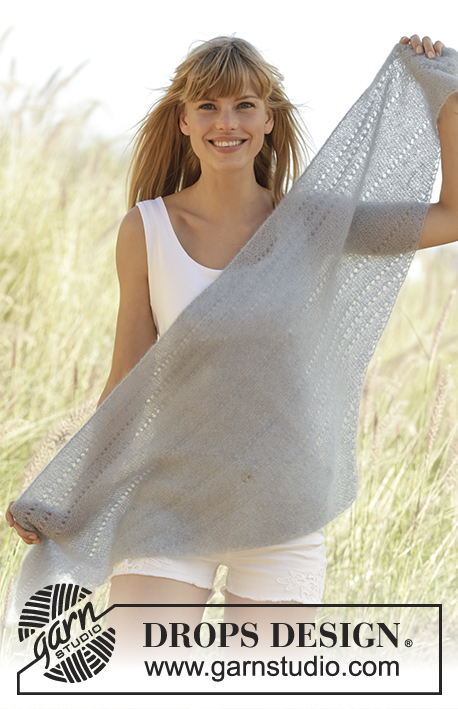 |
Knitted DROPS shawl in garter st with eyelet row in ”Kid-Silk”.
DROPS Extra 0-1269 |
|
|
GARTER ST (back and forth): K all rows. 1 ridge = 2 rows K. EYELET ROW: ROW 1 (= RS): Work and inc as before over the outermost 4 sts, K until 4 sts remain, K 4. ROW 2 (= WS): Work and inc as before over the outermost 4 sts, P until 4 sts remain, K 4. ROW 3 (= RS): Work and inc as before over the outermost 4 sts, * K 2 tog, 1 YO *, repeat from *-* until 4 sts remain, K 4. ROW 4 (= WS): As 2nd row. PATTERN-1: * Work 16 ridges in GARTER ST - see explanation above, and 1 EYELET ROW *, repeat from *-* 2 times in total. PATTERN-2: * Work 4 ridges and 1 EYELET ROW - see explanation above *, repeat from *-* 2 times in total and work 8 ridges and 1 EYELET ROW. KNITTING TIP: If you want a bigger shawl work entire pattern 2, then continue with pattern 1 until desired size - adjust to avoid casting off straight after an eyelet row. ---------------------------------------------------------- SHAWL: Worked back and forth on circular needle to make room for all the sts. Cast on 2 sts on circular needle size 4 mm with Kid-Silk. Then work PATTERN-1 - see explanation above - while AT THE SAME TIME inc in the sides as follows: ROW 1-2: K 1, 1 YO and K rest of row. ROW 3-4: K 1, 1 YO, K 1, 1 YO and K rest of row. REMEMBER THE KNITTING TENSION Repeat the 4 inc rows until finished measurements. NOTE: Make sure to always work eyelet row from the same side of piece. When pattern-1 is done, work PATTERN-2 - see explanation above. Repeat pattern-1 and pattern-2 1 more time in total but on last repetition do not work the last eyelet row in pattern-2. Piece now measures approx. 57 cm measured in knitting direction - READ KNITTING TIP. Loosely cast off with double yarn. |
|
Have you finished this pattern?Tag your pictures with #dropspattern or submit them to the #dropsfan gallery. Do you need help with this pattern?You'll find 9 tutorial videos, a Comments/Questions area and more by visiting the pattern on garnstudio.com. © 1982-2025 DROPS Design A/S. We reserve all rights. This document, including all its sub-sections, has copyrights. Read more about what you can do with our patterns at the bottom of each pattern on our site. |
|








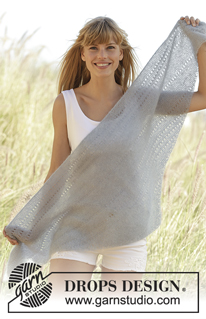



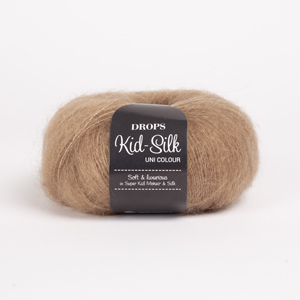
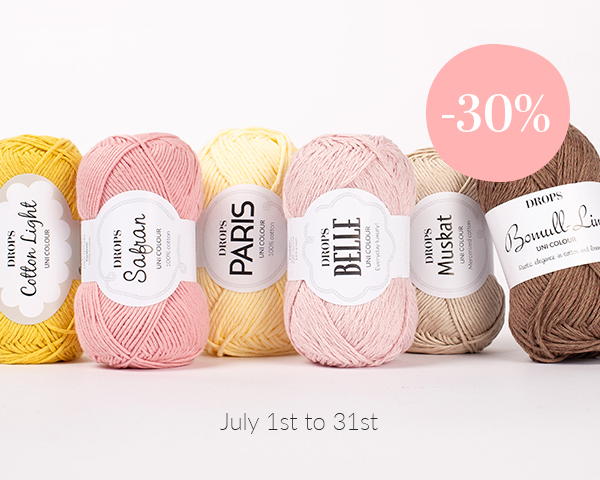

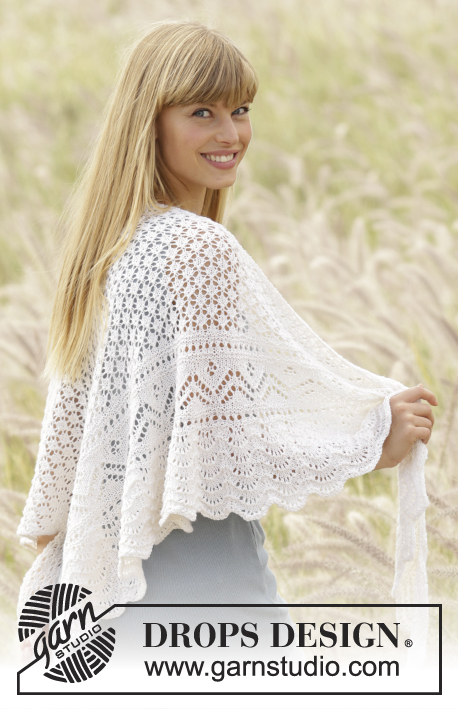

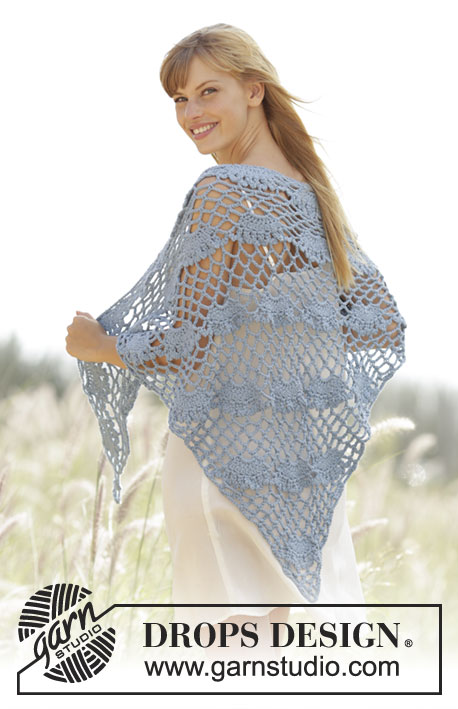



















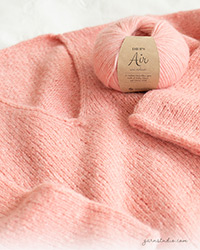


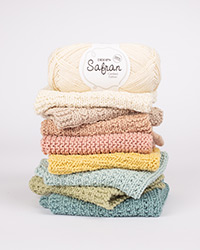
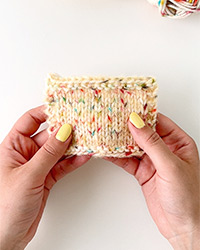
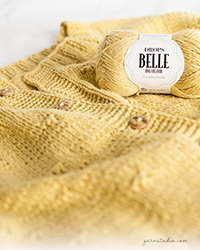
Post a comment to pattern DROPS Extra 0-1269
We would love to hear what you have to say about this pattern!
If you want to leave a question, please make sure you select the correct category in the form below, to speed up the answering process. Required fields are marked *.